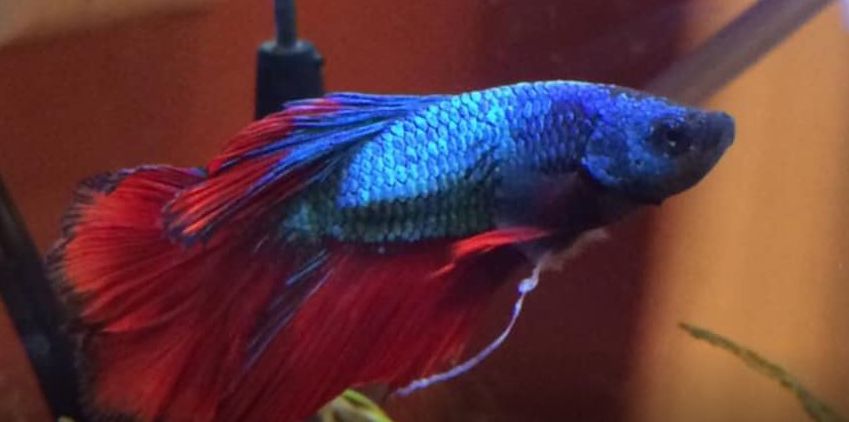
In “stringy white poop” the feces will stick to the fish and trail behind it in thin clear or white threads with brown patches. Stringy clear or white poop CAN be mucus from severely infected intestines. Most of the time it means nothing. White poop or clear poop in fish is like diarrhea in humans. It is common and generally not a cause for concern.
In my tanks with crystal clear water and being fed 55% protein food I see a lot of white poop. The fish who get white poop never have further health problems. So at this point I don’t pay any attention to white stringy poop.
One shouldn’t try to diagnose a fish as having anything wrong with it if it ONLY has clear or white poop. Wait till another symptom appears. Six out of the seven fish shown in this article which have white stringy poop have no associated symptoms and are probably just fine (one has Malawi bloat). These other associated symptoms include:
- It isn’t eating
- It is spitting it’s food out
- It has a swollen belly (“bloat” or “dropsy”)
- It has a hollow belly (“wasting disease”)
All these symptoms in conjunction with white poop indicate inflamed intestines, i.e. an intestinal infection by “internal parasites”, “worms”, or bacteria. They require treatment in the food and ONLY in the food.
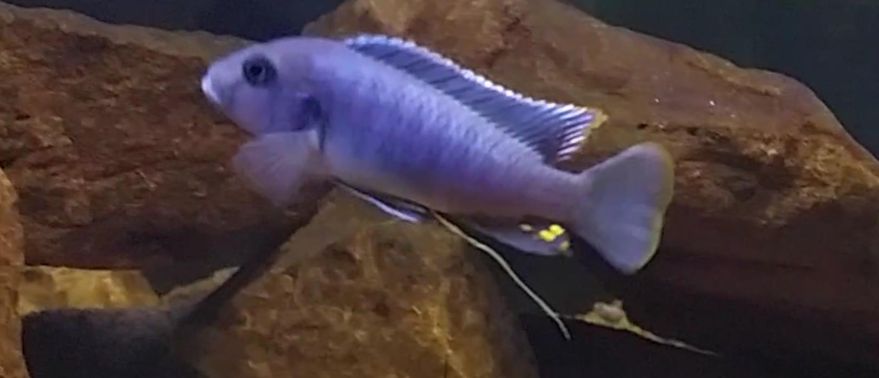
Necropsies on dead fish with “stringy white poop” and any of the above symptoms combined show the following incidence:
- 40% have “hexamita” (treat with metronidazole and Epsom salts)
- 30% have capillaria (treat with Fenbendazole)
- 20% have bacterial infections (treat with antibiotic)
- 10% have no apparent pathogen
To treat “stringy white poop” with an associated symptom make special food. Make a concentrated solution of Epsom salts (magnesium sulfate) (takes time to dissolve), two tablespoons Epsom salts in a cup of water. Better yet buy magnesium citrate solution from your local pharmacy (it’s like Epsom salts, a laxative) and use it just as is out of the bottle. Buy SeaChem MetroPlex, Thomas Labs Fish Bendazole and Maracyn 2 over the internet (many other options are listed below).
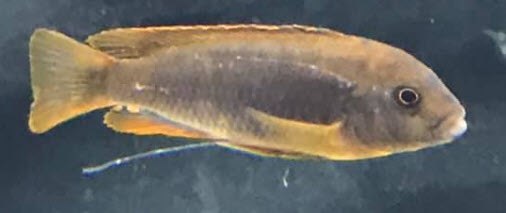
It is easy to make medicated food. Heat 1/4 cup magnesium solution (two ounces or 58 milliliters, not a lot) in the microwave. Then blend seven grams of plain animal derived gelatin (Knox gelatin, one packet) into the hot solution with vigorous stirring. Take two tablespoons of dry commercial fish food (pellets or flake) and mix it with just a little of the hot solution/ gelatin mixture. Add hot solution/gelatin until you get a paste like consistency. If it gets too watery just add more food.
Then add roughly 1/16 teaspoon (a 1% to 2% addition) of each of the medications to the mud. Mix and mash the whole mass thoroughly. Spread it out into a pancake about 1/8th inch (3 mm) thick on a plastic film or a plate. Then put in the refrigerator. If you plan on keeping it for more than two weeks put it in a small plastic bag and freeze.
Feed it to your fish for one month. Note while the fish won’t eat it like they normally do, they typically will eat some if you just leave it in the tank.
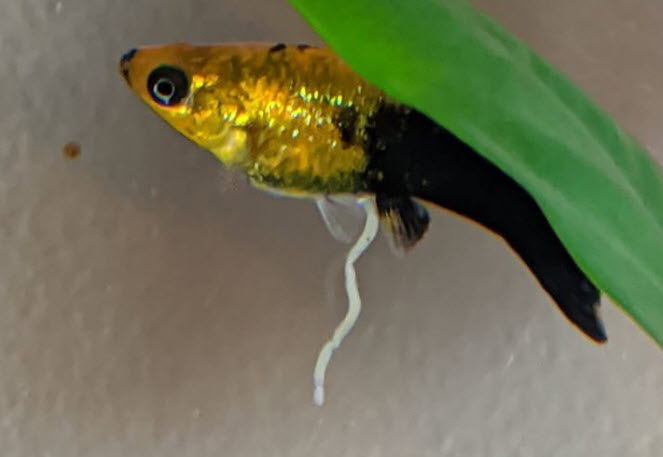
The treatment for “stringy white poop” with other symptoms has some options:
- Metronidazole, alias metro’ is available as API General Cure, SeaChem MetroPlex (both simply mixed into the food), or Hikari Metro Plus food or New Life Spectrum Hex-Shield food.
- Fenbendazole is available as Thomas Labs Fish Bendazole, Safeguard for dogs, or several livestock dewormers. Alternatively one can use Levamisole which is available on Amazon or at subaquaria .com or Valleyvet .com. Levamisole can be labeled as Agrilabs Prohibit Soluble Drench Powder and DURVET Levamed Soluble Drench Powder Dewormer. Other medications supposedly effective against roundworms are Pyrantel Pamoate, Flubendazole (Kusuri Wormer Plus) and Piperazine.
- Broad spectrum antibiotic available include Thomas Labs Fish Mox, Midland Vet Service Aqua-Mox, VetDepot Amoxicillin, SeaChem KanaPlex, Fishbiotic Ampicillin, Mardel Maracyn 2, Thomas Labs Fish Min or Thomas Labs Fish Doxy.
In API General Cure, metronidazole is combined with praziquantel. Praziquantel kills flukes and tapeworms. Tapeworms are rarely a cause of “white poop” disease so buying General Cure is a bit of a waste.
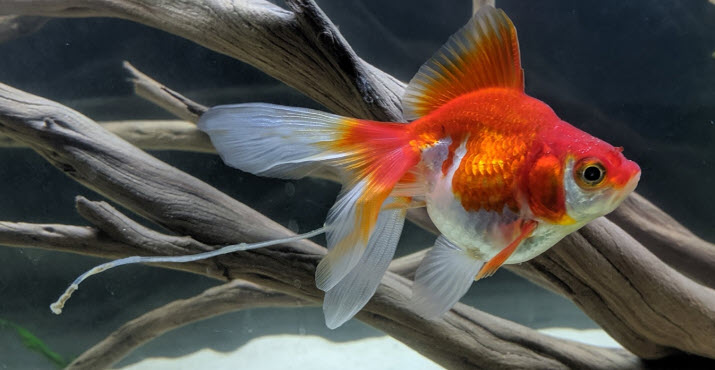
Per Wikipedia:
“Metronidazole is of the nitroimidazole class. It inhibits nucleic acid synthesis by disrupting the DNA of microbial cells. This function only occurs when metronidazole is partially reduced, and because this reduction usually happens only in anaerobic bacteria and protozoans, it has relatively little effect upon human cells or aerobic bacteria.”
So, metronidazole only works in the oxygen free environment of the fish’s intestine. And fish don’t drink (we cover that completely in another article). So, adding metronidazole to the water in the aquarium does not prevent the spread of the organism to other fish It only serves to give suppliers a lot of profit. Metronidazole also won’t kill beneficial bacteria in the biofilters because the filters are well aerated.
Metronidazole is FDA approved for use in humans, so we know it is very safe and effective. There is a “myth” that metronidazole must be handled with gloves as it will poison you through the skin or cause cancer. Since metronidazole (Flagyl) is approved to be swallowed in humans to treat some bacterial and protozoan diseases this is obviously very inaccurate.
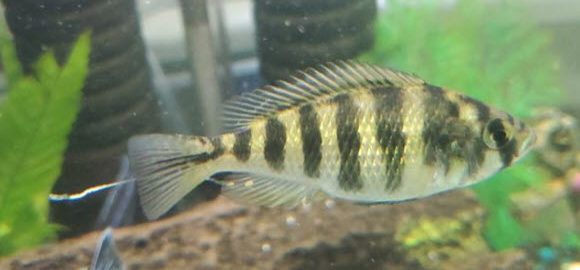
Epsom salts are a well-established treatment for “white poop” and hexamita. Per the research paper: “Treatment of Diplomonad Intestinal Parasites with Magnesium Sulphate at a Commercial Rainbow Trout Facility”, St-Hilaire et. al.:
“Rainbow trout (average weight of 2 g) in fresh water experienced high mortality and were infected with a diplomonad intestinal parasite. Aquariums of fish experienced an immediate reduction in mortality after an in-feed treatment with 3% Epsom salts for 2 d. Treatments had to be applied several times, but in each case, there was a similar reduction in mortality.”
Other references for this include Bamidgeh, 2005, and Noga, 1995. Note that by the terms “in-feed treatment” this reference meant where the Epsom salts were put in the food at the 3% level. They did not put the Epsom salts into the water.
Internal fish diseases such as stringy white poop can ONLY be treated with medications in the food. Many believe (and the instructions on the antibiotics say!) that fish medications need to be added to the water. They are simply incorrect. This controversial topic is covered in the following link:
12.5. Fish Don’t Drink
Another common combination is to have both bloat and white poop in a Lake Malawi fish, which speaks to the common genesis of both conditions:
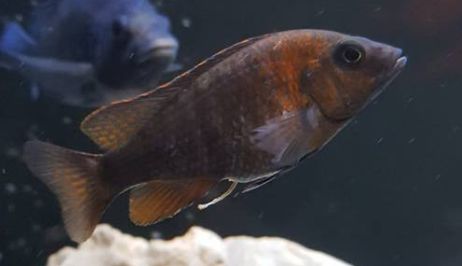
Most of the time, as with many fish diseases, poor water conditions (unclean bacteria laden water) are the root cause of “stringy white poop” with associated symptoms. But this is one case where fixing the water is closing the gate after the horse got out. You must treat with medications and Epsom salts to save the life of the fish IF AND ONLY IF THERE IS A SECOND SYMPTOM BEYOND WHITE POOP. Fixing the water conditions won’t save the life of the fish. Note that a case can be made that high carbohydrate foods also cause “stringy white poop”.
Note metronidazole is also effective against Clostridium difficile, an opportunistic anaerobic (very low oxygen) bacterium which is sometimes found in “stringy white poop” disease.
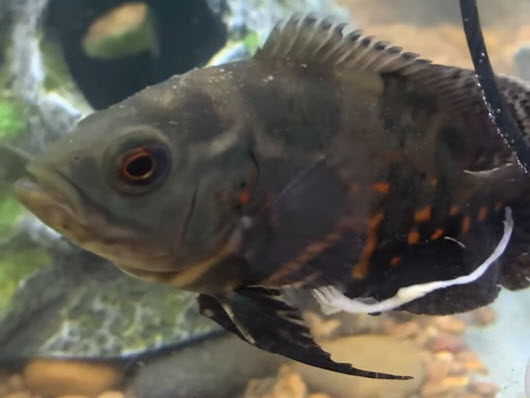
Further Reading:
The three big pathogens which cause “stringy white poop” are covered in the following links:
10.5. Hexamita
10.12.2. Capillaria
10.3. Bacterial Diseases
The symptom of “white poop” is often accompanied by another symptom. These symptoms are covered separately in these articles:
11.3.Malawi Bloat
11.4. Dropsy
11.5. Sunken Belly
11.15. Fish not Eating
.
Return to Symptoms Menu
.
Aquarium Science Website
The chapters shown below or on the right side in maroon lead to close to 400 articles on all aspects of keeping a freshwater aquarium. These articles have NO links to profit making sites and are thus unbiased in their recommendations, unlike all the for-profit sites you will find with Google. Bookmark and browse!
.

Dave says
In reply to Beth …. No good ideas at all. You are doing everything right and still losing fish. The yellow pus says it is bacterial. You might want to try several antibiotics like Maracyn 2 in the food together. Note that both Cornell University and the University of Florida offer services that do necropsies on fish.
Beth Lamson says
Hi David, I’m a huge fan and have read through your entire site multiple times since discovering it a few years ago & it has upped my game significantly. I recommend aquariumscience.org to every “fish person” I meet.
I’ve been seriously into freshwater aquariums for 30+ years, & have set up & maintained hundreds of tanks, mostly planted freshwater. I’ve been a hobby breeder of dozens of species since childhood. I have my own aquarium maintenance business, work at a pet store, etc., etc.
I’ve had a problem for the past year or two with reoccurring camalanus worms. I first started treating with febendazole in food, as per your medicated food recipe. Even after multiple treatments there was no apparent change. After months of that not working I treated w levamisole in food as per your recipe & treatment regiment. When that didn’t work after several treatments, I tried dosing the water w levamisole, which also hasn’t worked. Some of the worms do appear to get paralyzed and fall out, but they always reappear after a couple weeks or less, despite siphoning the substrate religiously after/during treatment. Typically I lose a few fish with every treatment, possibly due to worms dying inside the fish.
I’ve lost several hundreds of $ worth of fish in the last week and am getting pretty desperate. They (mostly angels & plecos) seem a bit “off”, hanging in a corner &/or surface, and within 24 hours are dead, many of them having sudden, severe bloat. I’ve cut open a few of the bellies of the deceased that had an unusual amount of a yellowish fluid built up in some organ, but I don’t know much about fish physiology or necropsies.
I’ve treated alternately w Prazipro, U.V. Sterilization, Epsom salts, antibiotics, API General Cure, & of course levamisole & febendazole. Do you have any insight or ideas for what I could try? Most (not all) of the other fish species are fine, & the plants are flourishing. I’m at a loss though and my most prized/expensive fish are dropping like flies.
0 ammonia, 0 nitrites, 20ish ppm nitrate. Ph 8. I’m running a well-established FX6 w sponge filters & tons of surface movement & aeration. Tap water is hard but that hasn’t been an issue in the past.
TIA. You are awesome.
Dave says
in reply to Ana …. In the absence of clear symptoms it could be any one of many pathogens or even a genetic problem. Just give it time and it might resolve itself.
Ana Adams says
My small koi has a sinking issue, he can’t maintain buoyancy, he has been moved from my outdoor pond into a 10gallon hospital tank. He’s been treated for bacteria and fungal issues. I’ve given him salt baths. He’s stronger now and likes to do loop de loops on his tank when I come by but eventually he ends up back on his side at the bottom. He’s not bloated, if anything looks thin but he’s still small only three inches long. He poops white sometimes but it’s not stringy and it seems to look like casing with white granules in it. I’m at a loss with how to help him and don’t know whether his condition is recoverable or if I need to think about euthanizing him